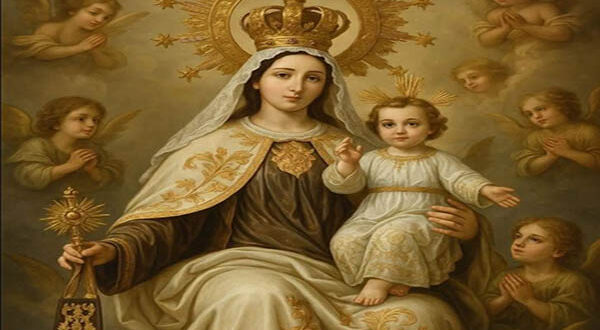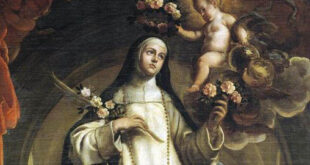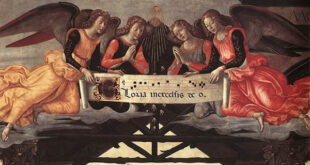“As a mother comforts her child, so I will comfort you.” (Isaiah 66:13)
Introduction
Every July 16th, the Church celebrates with joy to honor Our Lady of Mount Carmel, one of the most beloved and venerated Marian devotions throughout the Catholic world. From the fishermen of the Mediterranean to cloistered nuns, from faithful families praying the Rosary in their kitchens to the Carmelite friars high on the mount, all agree on one thing: devotion to Our Lady of Mount Carmel is warm, deep, and full of promises. But who really is Our Lady of Mount Carmel? Where does this devotion come from? What does theology teach about this Marian title? And above all, how can it transform our daily lives?
This article aims to be more than a historical lesson or a pious walk. It is meant to be a spiritual guide—an invitation to rediscover Mary as the Star of the Sea amid the storms of the modern world.
1. Biblical and Spiritual Origins of Carmel
Although the title “Our Lady of Mount Carmel” does not appear literally in Sacred Scripture, its root lies in a profoundly biblical geography and spirituality. Mount Carmel—whose Hebrew name Karmel means “God’s vineyard”—has been a sacred place since ancient times. The prophet Elijah lived there, and it was from this mountain that he proclaimed the sovereignty of Yahweh against the prophets of Baal (see 1 Kings 18). Thus, Carmel became a symbol of fidelity, prayer, and spiritual battle.
The spirituality of Carmel, centered on seeking the face of God in silence and contemplation, finds in Mary its perfect model. Mary is the praying woman, the one who keeps and ponders all things in her heart (see Luke 2:19). She is the small cloud Elijah saw rising from the sea as a sign of the rain of blessings after the drought (see 1 Kings 18:44): a prophetic image of the Virgin, bearer of the Savior.
2. Birth of the Devotion: From the Holy Land to Europe
Devotion to Our Lady of Mount Carmel began with the first hermits on Mount Carmel in the 12th century. These men, seeking to imitate the life of Elijah and live in solitude, built a chapel dedicated to the Virgin Mary, whom they soon began to call “Lady of the Place.”
When the Crusades ended and the Holy Land fell into Muslim hands, the Carmelites migrated to Europe. There, the Carmelite Order was officially recognized by the Church, and with it grew the devotion to their Patroness. In 1251, according to tradition, the Virgin appeared to Saint Simon Stock, Prior General of the Order, and gave him the Holy Scapular with the promise: “Whoever dies wearing this scapular shall not suffer eternal fire.”
This event marked a turning point: Our Lady of Mount Carmel became not only the protector of the Carmelites, but of all who devoutly wear her scapular—a sign of consecration and belonging to Mary.
3. The Scapular of Carmel: Theology and Commitment
The scapular of Mount Carmel is not an amulet nor a magical guarantee of salvation. It is a sacramental, that is, a sacred sign instituted by the Church that disposes the faithful to receive grace and cooperate with it. Wearing it with faith implies:
- Living in the state of grace, avoiding mortal sin.
- Imitating Mary’s virtues, especially purity, humility, and obedience.
- Praying constantly, with special attention to the Rosary and the liturgy.
- Practicing charity, as the fruit of a life in Christ.
The scapular is, in short, a spiritual “habit”: a daily way of clothing oneself in Christ through Mary. As Saint John Paul II, a great devotee of Our Lady of Mount Carmel, expressed it: “The scapular is an eloquent sign of the covenant between Mary and the faithful: it expresses the continual protection of the Virgin in this life and after death.”
4. When Is She Celebrated and What Is She Patroness Of?
The liturgical feast of Our Lady of Mount Carmel is celebrated on July 16th, in remembrance of her apparition to Saint Simon Stock. This date has been fervently embraced throughout the world, especially in Spain and Latin America.
Our Lady of Mount Carmel is:
- Patroness of the Carmelite Order, both the male and female branches.
- Patroness of the sea and sailors, by her title “Stella Maris” (Star of the Sea), guide and protector of those who sail.
- Patroness of the National Police in Spain, who adopted her as their protector in 1947.
- In many countries, she is also patroness of cities, towns, brotherhoods, and guilds, from fishermen to truck drivers.
Her image is venerated in countless shrines: from the Cerro de los Ángeles in Spain to the Shrine of Our Lady of Mount Carmel in Maipú, Chile; from Lima’s Carmelite sanctuary to the maritime processions of Cádiz, Málaga, or Cartagena.
5. Theological Significance of Our Lady of Mount Carmel
From a theological perspective, Our Lady of Mount Carmel represents Mary as:
a) Model of Contemplative Life
Mary is the woman who lives in total union with God. In her, the vocation of Carmel is fulfilled: silent prayer, recollection, listening to the Word. Her life is constant adoration. Therefore, the Carmelite (and every Christian) sees in her a mirror of the soul.
b) Powerful Intercessor and Spiritual Mother
The scapular symbolizes Mary’s protection, who intercedes for her children. The dogma of her spiritual motherhood, taught by the Second Vatican Council (Lumen Gentium, 62), finds a tender and approachable expression in Carmel. Mary not only cares—she also forms and guides toward Christ.
c) Consolation in Purgatory
Carmelite tradition speaks of the “Sabbatine Privilege”, an ancient belief approved by several popes, according to which the Virgin releases from Purgatory those who wear the scapular with devotion. Though not a dogma, this aspect expresses Mary’s maternal mercy toward suffering souls.
6. Our Lady of Mount Carmel Today: A Guide for the 21st Century
In a world marked by haste, superficiality, and the loss of transcendent meaning, Our Lady of Mount Carmel reminds us of what is essential:
- Interior Silence: against the noise of the world, Mary teaches us to gather ourselves, to pray, to contemplate. “The Virgin Mary advanced in her pilgrimage of faith,” says Vatican II. In her there was no anxiety or despair, but trust.
- Fidelity in Trials: in times of crisis, when everything shakes, Our Lady of Mount Carmel is a safe refuge. Refugium peccatorum, we rightfully call her. Her scapular is a promise that we are not alone.
- Path to Holiness: Mary not only intercedes, but also educates. She forms the heart of Christ within us. As a pedagogical mother, she instructs us in love, patience, purity, and strength.
7. How to Live Today Under the Mantle of Carmel?
Here are some practical suggestions to incorporate this devotion into your daily life:
- Consecration to Our Lady of Mount Carmel: make a personal or communal prayer, offering your life, family, work, and projects to her care.
- Wearing the scapular: receive the scapular from a priest and wear it with faith, living according to the demands of the Gospel.
- Daily prayer to Mary: pray each day the prayer of Our Lady of Mount Carmel or the Hail Mary with filial confidence.
- Imitate her virtues: in humility, silence, obedience, and love, Mary is our teacher.
- Remember the souls of the departed: offer Masses and prayers for the souls in Purgatory, especially on Saturdays, in Mary’s honor.
Conclusion
Our Lady of Mount Carmel is not a distant character or a romantic tradition of the past. She is a living and powerful presence, an attentive mother, a sure guide. In her are found the fire of Elijah, the beauty of contemplation, and the tenderness of motherhood.
Today more than ever we need to return to Mary, to wear the scapular of love, and to let ourselves be guided by the Star of the Sea. Because in the midst of the storm of the modern world, there is a Mother who never ceases to watch over the boat, saying with a firm and gentle voice: “Do whatever He tells you.” (John 2:5)
Holy Mary of Mount Carmel, pray for us.
Mother and Queen of Carmel, lead us to the Heart of your Son.
Amen.






